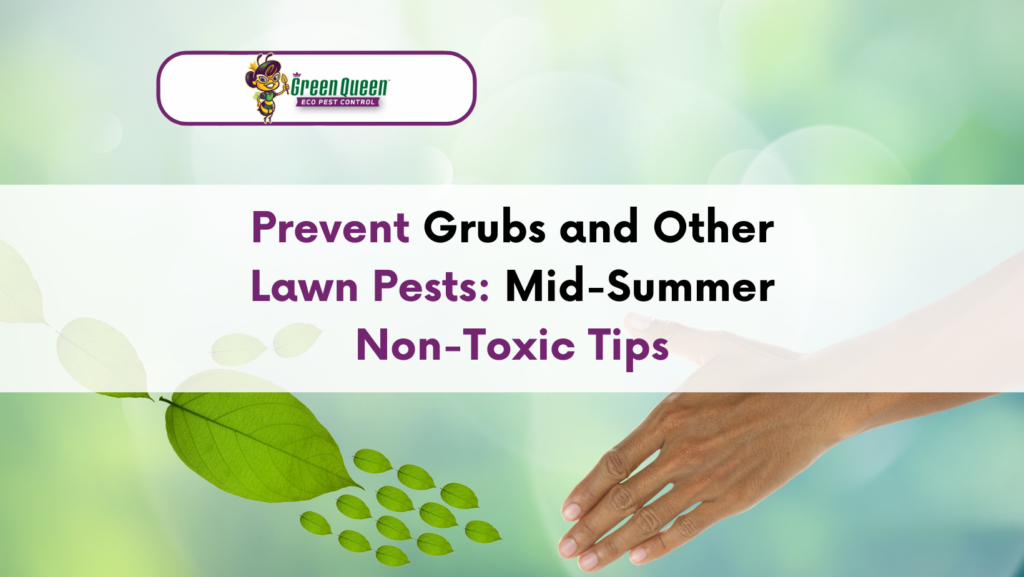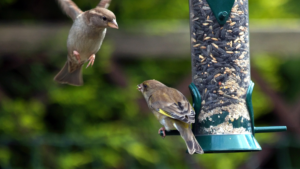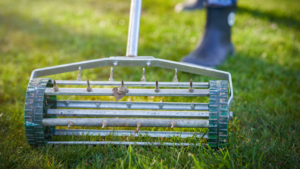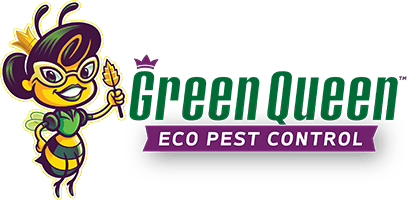
Prevent Grubs and Other Lawn Pests: Mid-Summer Non-Toxic Tips
Summer is a great time to enjoy your lawn, but it’s also when various pests can cause damage. Grubs, Japanese beetles, and other pests can create brown patches and weaken your grass. Understanding how to manage these pests using non-toxic methods will help you maintain a healthy lawn without harming the environment.
Traditional pest control methods often rely on harsh chemicals that can be harmful to pets, children, and beneficial insects. Non-toxic solutions, on the other hand, are safer and just as effective. They allow you to protect your lawn in a way that’s friendly to the ecosystem.
With that in mind, we’ll explore common lawn pests that trouble Atlanta residents during mid-summer, and provide practical tips to control them. By using non-toxic methods, you can ensure your lawn stays green and inviting all summer long.

Understanding Common Lawn Pests in Atlanta
Atlanta’s warm and humid summer climate makes it a hotbed for various lawn pests. These pests can damage your turf, leading to unsightly patches and weakened grass. Here’s a look at some common culprits:
1. Grubs: These are the larvae of beetles and are among the most destructive lawn pests. They feed on grass roots, causing dead patches on your lawn.
2. Japanese Beetles: As adults, these beetles feed on plant leaves, but it’s their larvae, grubs, that are particularly harmful to lawns.
3. Chinch Bugs: These tiny insects suck the sap from grass blades, leading to yellow or brown patches.
4. Armyworms: These pests eat grass leaves and can quickly destroy large areas of turf if not controlled.
5. Sod Webworms: The larvae of these moths create silken tunnels in the soil and feed on the grass, leading to brown spots.
Recognizing these pests early allows you to take action before they cause significant damage.
Why Non-Toxic Pest Control Is Important
Using non-toxic pest control methods benefits both your lawn and the environment. Traditional chemical pesticides may provide quick results, but they come with several downsides:
1. Health Hazards: Chemical pesticides can be dangerous for humans, pets, and beneficial insects. They can cause allergies, respiratory issues, and other health problems.
2. Environmental Impact: Chemicals can leach into the soil and water, harming local wildlife and plants. They can disrupt the ecosystem balance and lead to long-term soil degradation.
3. Resistance: Over time, pests can develop resistance to chemical pesticides, making them less effective.
Non-toxic solutions, on the other hand, promote a safer, healthier approach to pest control. They target pests without harming beneficial organisms, ensuring that your lawn thrives in a natural and sustainable way.
Identifying Grubs in Your Lawn
Grubs are one of the most damaging lawn pests, so early identification is crucial. Here are some signs to look for:
1. Dead Patches: Brown or dead patches in your lawn may indicate grub activity. These patches can easily be pulled up like a carpet if grubs have eaten away the roots.
2. Increased Bird Activity: Birds pecking at your lawn may be hunting for grubs beneath the surface.
3. Spongy Turf: Your grass may feel spongy, indicating that roots have been eaten away.
To confirm the presence of grubs:
1. Inspect the Soil: Dig up a section of your lawn about 2-4 inches deep. If you find more than five grubs per square foot, you have a grub problem.
2. Check for Beetles: Note if you see an increase in beetle activity, as these are the adult form of grubs.
Non-Toxic Methods to Control Grubs
Once you’ve identified a grub problem, there are several non-toxic methods to control them:
1. Milky Spore: This natural bacterium specifically targets grubs. Apply it to your lawn; it spreads through the soil and infects the grubs, killing them without harming other insects or plants.
2. Nematodes: Beneficial nematodes are microscopic worms that invade and kill grubs. Mix them with water and spray them on your lawn for effective control.
3. Neem Oil: This natural oil can deter grubs and other pests. Mix it with water and spray it on affected areas.
4. Diatomaceous Earth: Sprinkle this fine powder on your lawn to kill grubs. It’s safer for humans and pets but deadly to insects.
By using these non-toxic methods, you can effectively manage grub populations and protect your lawn without harming the environment.
Preventing Japanese Beetles and Other Lawn Pests
Japanese beetles can wreak havoc on your lawn and garden. Preventing them from taking hold is essential for maintaining healthy turf. Here are some non-toxic strategies to keep these pests at bay:
1. Neem Oil: This natural insecticide disrupts the life cycle of Japanese beetles. Spray neem oil on affected plants to deter adult beetles and prevent eggs from hatching.
2. Row Covers: Use floating row covers to protect young plants from beetle damage. These covers are lightweight and allow sunlight and water to penetrate but keep beetles out.
3. Companion Planting: Plant garlic, chives, and marigolds around your garden. These plants can repel Japanese beetles and other pests naturally.
4. Hand Removal: In the early morning when beetles are less active, handpick them off plants and drop them into a soapy water solution to kill them.
Consistent application of these methods will ensure your lawn and garden remain healthy and beetle-free.
Using Natural Predators to Keep Pests in Check
Natural predators can be your allies in controlling lawn pests. Encouraging these beneficial creatures to inhabit your yard can reduce the need for chemical treatments.

1. Birds: Many birds, such as robins and bluebirds, eat lawn pests like grubs and beetles. Provide birdhouses, feeders, and water sources to attract these helpful birds.
2. Ladybugs and Lacewings: These insects prey on aphids, mites, and other small pests. You can buy ladybugs and lacewings from garden centers and release them in your yard.
3. Nematodes: Beneficial nematodes are microscopic worms that target soil-dwelling pests like grubs. Apply them to your lawn to infect and kill these pests naturally.
4. Frogs and Toads: Create a small water feature to attract frogs and toads. These amphibians can consume large quantities of insects and pests.
By fostering a habitat for natural predators, you can maintain a healthy, balanced ecosystem in your yard.
Creating a Healthy Lawn to Resist Pests
A strong, healthy lawn is less susceptible to pest damage. Here are steps you can take to promote lawn health and resilience:

1. Proper Watering: Water your lawn deeply but infrequently. This encourages deep root growth and makes your grass more drought-resistant. Water in the early morning to minimize evaporation.
2. Regular Mowing: Keep your grass at the recommended height for its type. Generally, mowing at a height of 2.5 to 3 inches helps the grass develop stronger roots and resist pests.
3. Aeration: Aerate your lawn once a year to improve soil structure and boost root growth. This process helps your grass absorb nutrients and water more efficiently.
4. Fertilization: Use organic fertilizers to provide essential nutrients without introducing harmful chemicals. Compost and natural fertilizers can enhance soil health and support vigorous grass growth.
By following these practices, your lawn will be more robust and better able to fend off pests naturally.
Non-Toxic Pest Control Products to Use
There are several non-toxic products available that can help manage lawn pests without harming your family or the environment. Here are some effective options:
1. Milky Spore: This organic bacterium targets grubs and is safer for humans and pets. Apply it to your lawn, and it will kill grubs over several years.
2. Neem Oil: Known for its insecticidal properties, neem oil is effective against a wide range of pests. Mix it with water and spray it on your lawn and plants.
3. Diatomaceous Earth: This natural powder dehydrates and kills insects on contact. Sprinkle it around problem areas to control pests.
4. Beneficial Insects: Purchase ladybugs, lacewings, and nematodes from garden centers. Release them in your yard to naturally reduce pest populations.
5. Garlic Spray: Garlic-based sprays can repel many common pests. Use a commercial garlic spray or make your own by mixing garlic extract with water.
Using these non-toxic products ensures that your lawn remains safer for children and pets while effectively managing pests. By choosing eco-friendly options, you contribute to a healthier environment.
DIY Natural Pest Repellents
Keeping your lawn pest-free with natural methods is both safer and effective. Here are some DIY pest repellents you can easily make at home:
1. Garlic Spray: Mix crushed garlic with water and let it sit overnight. Strain and spray on your lawn to deter pests.
2. Neem Oil: Dilute neem oil with water and spray it on affected areas. Neem oil disrupts the life cycle of pests like grubs and beetles.
3. Essential Oils: Oils such as peppermint and eucalyptus can repel various pests. Mix a few drops with water and spray around your lawn.
Using these natural repellents can help keep your lawn healthy and free from harmful chemicals. They are easy to prepare and gentle on the environment.
Tips for Maintaining Your Lawn in Mid-Summer
Mid-summer is a critical time for lawn care. Here are some tips to keep your lawn in peak condition:
1. Water Early: Water your lawn early in the morning to maximize absorption and reduce evaporation. This keeps your grass hydrated during the hot mid-day sun.
2. Mow High: Set your mower to a higher setting. Longer grass shades the soil, keeping it cooler and reducing weed growth.
3. Aerate the Soil: Aerating helps oxygen, water, and nutrients reach the roots more effectively. This promotes healthier and stronger grass.
Following these tips can keep your lawn looking lush and healthy even during the hottest months.
Frequently Asked Questions About Non-Toxic Lawn Care
1. What are the benefits of non-toxic lawn care?
Non-toxic methods are safer for children, pets, and the environment. They help maintain an eco-friendly lawn without harmful side effects.
2. Can I use non-toxic methods on all lawn pests?
Yes, there are natural solutions for most lawn pests, including grubs and Japanese beetles. Non-toxic methods are versatile and effective.
3. How often should I apply natural pest repellent?
This depends on the type of repellent and the level of infestation. Generally, applying it once a week should keep pests at bay.
Take Action with Green Queen
Everyone wants a healthy, green lawn without harmful chemicals. At Green Queen, we provide effective, non-toxic pest control solutions designed to keep your lawn in the best shape. Our methods are safer for your family, pets, and the environment.
After all, maintaining a healthy lawn free of pests doesn’t have to involve toxic chemicals. By understanding common pests and using natural repellents, you can create a safe and beautiful outdoor space. Mid-summer lawn care involves a few essential steps, but with the right approach, your lawn can thrive.
Partner with Green Queen for non-toxic lawn care solutions in Atlanta. Discover how our methods can benefit your lawn and your family. Contact us today to start your journey toward a healthier, greener lawn!
